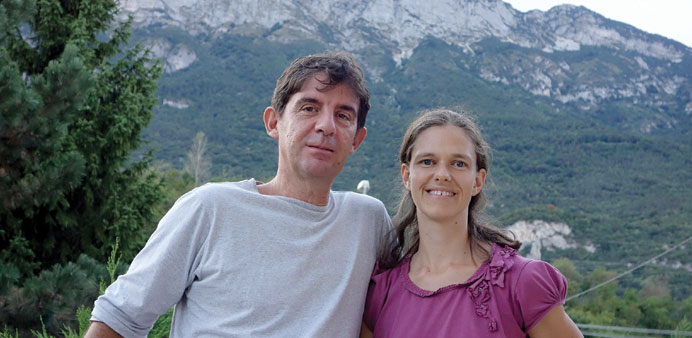FEARFUL: Moira Panazzolo, right, and her partner, Giovanni in the garden of their house in Terlago, a small community near Trient, Italy. She avoids going out at night for fear of bears, and is cautious about walks in the daytime.
By Annette Reuther
The house, sandwiched between mountains and lakes and surrounded by vegetable garden, fruit trees, swings and rabbit hutches, could hardly be more idyllic.
But Moira Panazzaolo isn’t always keen to venture out into the pristine scenery.
“When it gets dark I feel like I’m in danger just two steps away from the house or taking out the rubbish,” she says.
She lives with her partner Giovanni and two small children in the village of Terlago in northern Italy — and she’s afraid of bears.
“I jump at the slightest sound. I don’t want to feel like that.”
The project Life Ursus has been running for the past 16 years and involves reintroducing brown bears to the region.
Since the first bears were brought from Slovenia to the Adamello-Brenta nature park, the population has increased to 50 bears.
One of them caused a diplomatic incident in 2006 when he wandered all the way to Germany. Bruno was subsequently shot as a menace and his stuffed body displayed in a museum. The incensed Italians demanded his return.
Other bears in the region are now showing the same aggressive tendencies as Bruno.
In June a female brown bear known as KJ2 — who is still being searched for — mauled a jogger, seriously injuring him.
Last year, a mother bear, Danize, attacked a mushroom picker. The bear failed to wake up from the anaesthetic that was given to her during her capture.
The events have only served to further strain relations between man and beast.
“Even though I know I’m statistically more likely to get run over by a car than be eaten by a bear, I’m still scared,” says Panazzolo.
The problem has been recognised by the authorities.
“At the beginning, support for the reintroduction (of bears) was much greater. Now the contra party are greater. Lots of people are afraid of the bear. That’s a problem,” says Claudio Groff, who’s responsible for bears in the autonomous province of Trient.
Communication with the locals has to improve, he says.
Bureaucracy between the Environment Ministry in Rome — which is in overall charge of the reintroduction programme — and the province slows any reaction to “problem bears,” the term used by European officials for individual animals that lose their fear of humans and begin attacking sheep and people.
Protection measures are also often ineffective. Tests on electric fences, for example, showed that many of them didn’t work properly.
The state parliament in Trentino recently decided that the bear population should be reduced. The far-right Lega Nord party, which is strong in northern Italy, has also demanded a referendum to show how many people are for and against the bears.
“We already know that the majority of people are against the bears. So a referendum would be completely superfluous,” says Groff.
A better answer would be to rapidly and reliably eliminate the “few problem bears.”
“These animals get too close to humans and cause too much damage,” he says. One way would be to capture them, another to shoot them — a solution which outrages environmentalists.
There are also concerns about the tourism industry. “Of course some tourists are also worried,” says Groff. But this summer the region experienced a record number of tourists, so the bears are not deterring people from enjoying the great outdoors in Trentino.
Environmentalists say people are getting too close to the bears’ natural habitat. They say it has been more important to the region to open new ski slopes and walking trails than to protect the environment.
They also say that the people involved themselves are really responsible for the bears’ rare attacks on them.
“The accidents are sad but they’re due to the fact that the local population in Trentino and especially tourists from Germany still have to learn how to behave around bears,” says Ruediger Schmiedel from the Foundation for Bears (Stiftung fuer Baeren) at Worbis, Germany.
There’s still the question of what happens if another “problem bear” decides to go further afield.
“Bruno made it to Germany. The bigger the population in Trentino gets, the bigger the probability that another bear will do the same,” he says. —DPA

